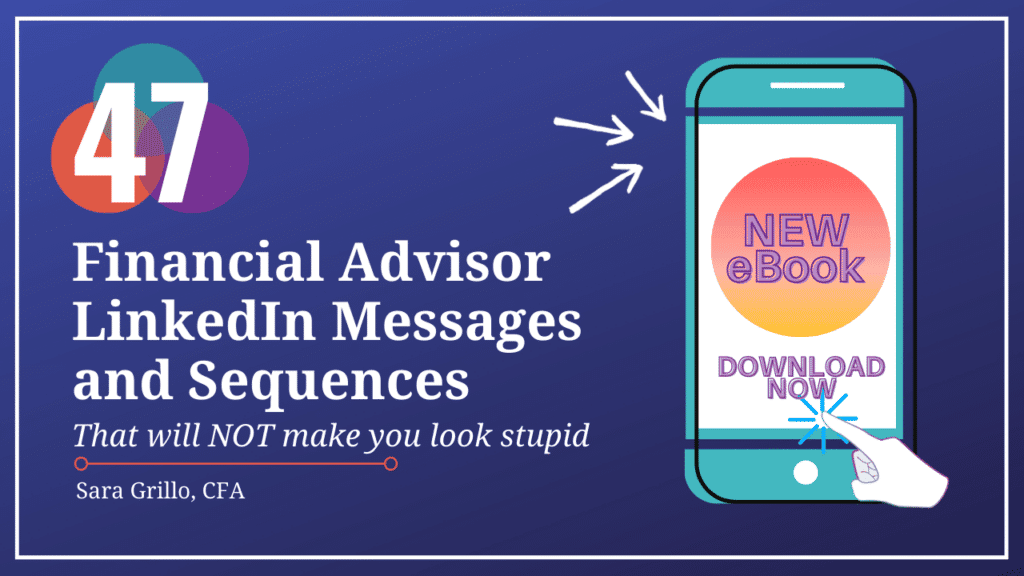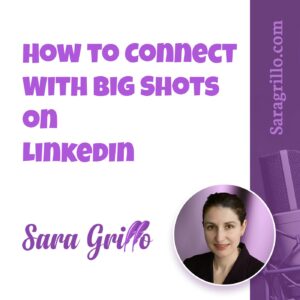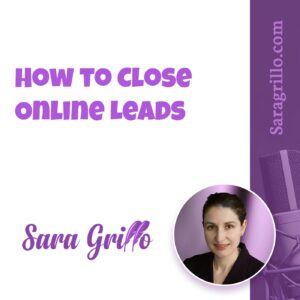Podcast: Play in new window | Download
This podcast/blog is going to be about financial advisor sales funnels and why they freeeeaking bite. And then I’m going to tell you what nobody else talks about – the real story about how to make yours better!
Welcome to my blog/podcast!

Pleased to meet you!
For those of you new to my show, I am Sara Grillo, a CFA charterholder, marketing consultant, and former financial advisor. Please subscribe to my weekly newsletter so you won’t miss any of these insightful and fun tips about financial advisor lead generation!
What to expect out of this blog
To sum up, in this blog you will learn:
- What a financial advisor sales funnel is
- What the 3 critical elements are
- What’s wrong with most financial advisor sales funnels
- How to structure a successful financial advisor sales funnel
So now for the blog/podcast. Let’s get started!
What is a Financial Advisor Sales Funnel?
Now, let’s start with the definition of what a financial advisor sales funnel is. To clarify, a financial advisor sales funnel is a series of interactions designed to get new leads and follow up with them until they agree to be your client. It is usually automated and can include:
- Phone calls
- Newsletters
- Social media
- Drop in visits
- Mailers
Some financial advisors have no sales funnel and do no follow up at all. On the other hand, others do too much. Therefore, to have an effective sales funnel, a financial advisor has to strike a balance in between the two. Above all, follow up is important.
The Funnel = giving
I’ll also say that I don’t like the term “sales funnel” or “lead funnel” as many financial advisor marketing consultants refer to it. The reason is that nobody likes feeling like they are part of a funnel, moved along like an inanimate object, sucked down some tube like a piece of dust littering your drapery. I like to use the term “Giving process” because that is what it should be: a series of exchanges where the prospect feels nurtured in a human way and given valuable information that improves their wellbeing.
GIVE don’t take; give more than you take; give before you take.
That’s the most important part about a financial advisor sales funnel (which is a term I really do find quite indelicate but kind have to use because it’s the phrase everyone is used to hearing).
Don’t give me that line about “the service sells itself” or that you have such a good reputation that you don’t need to do this. Even if you get the most shining introduction/referral in the world, the deal is still yours to lose. It’s not closed until it’s closed. Having said that, every deal is different. Some you have to push along while others need to be nurtured.
Here’s another way to define a financial advisor sales funnel. It is the process of nurturing a relationship with someone you do not know so that they eventually feel comfortable enough with you and the value of your service.
So, what are the elements of a financial advisor sales funnel?
The Three Main Parts
- Gathering the lead by getting the prospect’s attention through marketing
- Nurturing the relationship through follow up
- Closing the relationship by getting the prospect to agree to work with you (and they sign the papers)
Note, no prospect has moved out of the funnel until the papers are signed.
Certainly, this is going to take work. But purely by the fact that you put effort into it you’ll be separating yourself from others who aren’t willing to.
Let me tell you a quick story. There’s an advisor on my membership who once told me that he wanted to get a reporter to interview him. Apparently the reporter had written a story about a subject the advisor knew a lot about, and he thought it would be a great sequel story for the reporter to interview him. As a result, I have a whole video in my membership that discusses how to get a reporter’s attention. It’s not the typical line of “Hey my name is Jane and I think you should interview me for your next article because I know everything about Roth IRAs.” Boring! And totally self-centered. Remember that reporters hear from these takers all the time and they are exhausted of it.
Don’t be a taker!
I clearly outlined the steps the advisors should take to get the reporter’s attention and nurture a relationship with him/her so that over time the reporter will trust the advisor and eventually call him up to interview him. I mean, these are proven techniques that work. However the advisor responded with, “That’s too much work. I’ll just email him/her as I originally planned.”
It’s not like we all haven’t done this and in fact it is quite common. Seeing sales follow up as pointless is a one-sided mistake is a trap that many of us fall into. That is why it’s so important for financial advisors to clearly understand the objective of a sales funnel – which is what I am going to cover next.
What is the objective of sales follow up?
Many financial advisors disregard sales follow up, saying that line of “if the prospect is interested, they’ll call me.” Well, maybe in some cases but given you are asking them to pay you $10k or more a year, most of the time you are going to have to give them a little bit more than a nudge.
Sales follow up is in many ways the most important part of your relationship with a prospect for a few reasons.
- It is the time of highest learning between you and someone who doesn’t know you well
- It sets the tone for the future of the relationship
- It is the one of the biggest opportunities to separate yourself from other financial advisors if you do this right
So, let me go to the learning part in more detail.
The power exchange; the influence must be given not taken
When a financial advisor meets a prospect, either through cold marketing or a warm referral, the onus is on the financial advisor to close the deal. The advisor has none of the power, and the prospect has all the power.
So, how does the financial advisor wield power away from the prospect?
By getting the prospect to give him or her the information that he or she needs to gain trust. In conclusion, this is done through positive interactions in which the prospect is made to feel comfortable with the advisor and compelled to provide this information to him or her.
However, if you make no effort to follow up at all, what information is the financial advisor getting about the prospect?
None.
What information are you giving the prospect about you? That you don’t really care about the relationship.
No information exchanged during prospecting = no power exchanged between advisor and prospect
High information exchanged during prospecting = advisor gains influence over prospect
For instance, let’s say that you work along the funnel. With every interaction, the financial advisor gains a little bit more information. He or she then leverages that information to build more trust. The next interaction, the advisor gains more information. He or she then leverages that to build more trust, and one and on.
Now let’s look at how the learning is developing from the prospect’s point of view. The prospect is learning about the financial advisor through this process. It could be, geez, look at how prompt she was when she returned my phone call. Wow, I love how she wrote her last email newsletter. The financial advisor is making an impression on the prospect with every interaction. They started with no information and little by little gained information over time about the financial advisor and hopefully how great he or she is.
During the prospecting process, the follow up is the relationship!
So, what is the objective of follow up in the financial advisor prospecting process? Most importantly, the eventual goal is to get the prospect to sign the documents. But the immediate goal is to stage a series of interactions that get the prospect to response.
Remember, when they respond they give you information. And information = power as we already discussed.
And by the way, even if they don’t respond they are giving you information. To clarify, they are telling you what they see to be of no importance to them.
Now that we’ve established that the objective of sales follow up is to learn about the prospect, let’s talk about how to arrange a series of interactions that will do just that.
Let’s start with what not to do first – shall we?
What a Financial Advisor Sales Funnel should NOT be
To clarify, you financial advisors have got to understand something upfront. Most of you are not IBM, you’re not Apple Computer, you’re not Amazon. Above all, you’re not selling pampers and twisty ties. And you don’t have 500 new leads a day to take care of. However, maybe Ric Edelman does. But he’s the rare exception.
Although I absolutely see the need for routine and regular follow up, and I see the value in this follow up being automated to some extent, I strongly disagree with the idea that financial advisor sales funnels should be highly mechanical.
Come on people, you’re not asking them to buy a box of Pampers for $36.99. You’re asking them to tell you their deepest secrets such as how much they make, where they bank, and the fact that the hate their daughter’s fiancé and want him disinherited from their will.
However, none of you have the volume of leads where you need to automate your follow up. Most of you have less than 20 prospects at any given time. But, you can’t deal with them one on one?
Tell me, financial advisors, who likes being so obviously a part of somebody’s sales funnel? Who likes being “sales funneled?”
There is way too much sales funnel going on and not enough financial advisors taking the time to read into the prospect’s mind and try to figure out what they really need to hear about from you!
Let me put it differently.
When you follow up in a highly automated way without a personal touch or attention to the particular prospect’s needs, luxury buyers do not respond! You know these automated funnel things – you send an email and then whoever responds gets another email, and then
Get a list of 20 prospects.
Certainly, you don’t need 500 prospects. Above all, you can’t pay high attention to 500 people. On the other hand, get 20 people who are qualified and the right type of person that you want to do business with. Highly profitable, good assets, not DIYers, not broke, not going to haggle you over fees. Get those 20 people and then get them into a funnel but don’t have it be robotic because R2D2 and C3Po were not programmed to read the high net worth individual’s mindset!
Use the force, Luke!
You can automate your sales funnel somewhat, but I’m not a fan of having it on autopilot. I mean, it sounds good. Set up an email campaign and let the weekly emails fly. You don’t have to sweat out following up with every prospect and heck, you maybe even be able to get away with sending them canned content!
You can try it but I think you’ll have better results varying the automation. One week the follow up is an email blast, and then maybe the next week you send the automated follow up. But then get off autopilot. Assess results. See who is clicking and who is not clicking. See who has unsubscribed. Do an individualized follow up instead of an automatic one the next week.
What a financial advisor sales funnel should be
Above all, it should be fun! Connecting with other human beings, and getting a cool response, is fun! Let’s put some of the fun back into sales funnel.
For example, let me tell you my motorcycle story.
A while ago, there was a prospect that I talked to and the meeting didn’t go awesome. Afterwards the relationship went into a stall where he wasn’t responding to me. So I called up his administrative assistant and asked her what his favorite hobby was. She said that he loved motorcycles. So I got on Amazon, found a cool motorcycle book, and had it sent to his office. About a week later he emailed me, overjoyed, and within a few days the deal was signed.
Now, it’s not necessarily going to go as smoothly as that, but it’s clear that the personal touch took a depressing outcome of being blown off by a prospect and turned it into a fun outcome which was him having fun reading a cool book about motorcycles and me closing the deal.
And, to quote the Beetles:
And if you want some fun
Take Ob-la-di-bla-da
So, to review, the components of a financial advisor sales funnel are:
- Getting the lead
- Nurturing the lead through a series of information-yielding interactions
- Closing the deal
Getting the lead
So, how do you get people to come into your sales funnel? You can go about it a variety of ways. They are covered in this video below.
Financial advisors prospecting online are going to need a good lead magnet. To clarify, a lead magnet is a downloadable document that a financial advisor gives a prospect in exchange for the right to get their email address and add them into their sales funnel. The invitation to “have coffee and chat” is not a financial advisor lead magnet.
For example, here are a few:
- Retirement income calculator
- Cash flow worksheet
- Sample Investment Policy Statement
These are typical and kinda boring though. For some lead magnets that make the prospect go “HECK YEAH”, check out my blog on lead magnets.
Moving people along the Giving Process
How often do you follow up with a prospect in your sales funnel? It depends on the nature of the relationship but a good guideline is once a week. These follow ups should be designed to illicit a response from the prospect although in some instances the goal is simply to provoke thought.
To clarify, it’s important to vary the type of interaction and definitely don’t send that “just touching base” email or voicemail incessantly like most people do. For example, here are some creative ways for financial advisors to follow up with prospects in their sales funnels:
- Send something in the mail
- Find out what type of cartoons their kids like and send them a face mask
- Send them a book
- Like their Facebook page
- Buy something from their business
- Send them a client
- Send them a referral
- Make a comment on their LinkedIn postings
- Send them a note in the mail
- Leave them a cool voicemail that is funny or interesting
That is to say, if you do this with even one iota of creativity and you’ll get their attention and separate yourself from 99% of other financial advisors with no brand.
Closing the deal
Closing the deal is the last step of the financial advisor sales funnel. There is a common misperception, though, about what it takes to get this done. Most marketing consultants will teach you that you need some flashy lines and you have to deliver them with total perfection and then if you do all this then the deal will close.
The analogy I will make is that this is kind of like giving the prospect a task such as programming a computer in C++ and then expecting them to be able to do it by just reading the Cliff Notes.
You have not nurtured the understanding in their minds yet. And as a result, the words will have no meaning. They will fail to make the correct decisions when attempting to program the computer because they will be lost as to why to do this or that.
For example, suppose that you were to give them a weekly chapter from a book to read about C++. And all the while you are following up to make sure they comprehend, they got the point of what it was all about and why they needed to do what was outlined in the chapter. Now they are prepared mentally. Now things have meaning. You are leading them through the knowledge they need to be able to make the correct decisions on game day.
The Deal Closer
Executing a close is a science. It does have to be done succinctly and be done in a compelling way. However if you did things right during the sales funnel process then there should be enough force there to carry the deal through on its own with little prompting from you. So, to all those financial advisors who are frustrated by why they can’t close the deal, ask yourself this question.
Do you honestly think you got the right information from the prospect during the time you spent following up?
When a close fails, financial advisors should go back to the follow up phase of the sales funnel and repeat the action of following up in a more meaningful way. Do this until the proper information is yielded and you are able to leverage it to build up enough trust. But, do not attempt to close again until there is robust force present from the sales funnel.
Conclusion on how to make a financial advisor sales funnel that does not bite
So, thanks for reading my blog. Certainly, if you want to get a financial advisor sales funnel that does not bite, do a few things. 1) Get an awesome lead magnet that actually makes other people’s lives better 2) Follow up creatively and don’t be boring 3) Close only when you feel you and the prospect have learned enough about each other for the deal to naturally close on its own.
What’d ya think? Was this helpful?
If yes…
Learn what to say to prospects on social media messenger apps without sounding like a washing machine salesperson. This e-book contains 47 financial advisor LinkedIn messages, sequences, and scripts, and they are all two sentences or less.

You could also consider my financial advisor social media membership which teaches financial advisors how to get new clients and leads from LinkedIn.

Thanks for reading. I hope you’ll at least join my weekly newsletter about financial advisor lead generation.
See you in the next one!
-Sara G
Music is Much Higher by Causmic





